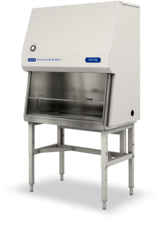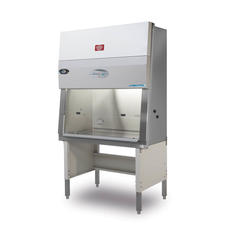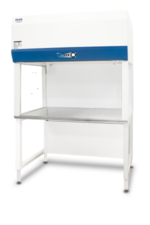Biological Safety Cabinets
Biological safety cabinets (BSCs) are designed to provide different levels of protection against biological hazards depending on the class of the cabinet. Class II cabinets, which are the most common on campus, provides 3 levels of protection: personnel, product, and environmental. Personnel protection is provided by the inward and downward vertical laminar airflow to create an air barrier to prevent airborne particles, such as aerosols and microorganisms, from leaving the cabinet. High Efficiency Particulate Air (HEPA) filters are used to clean the air going into the work area (product protection) and out to the environment (environmental protection). The HEPA filters remove aerosols and airborne particles from the air, but does not remove chemical fumes or vapors.
A BSC is different from other laboratory equipment that may look similar such as a chemical fume hood or laminar flow hood. A chemical fume hood, which are only designed to pull (not decontaminate) chemical fumes and vapors away from the work area. For biological work involving chemicals that produces vapors or fumes, the use of a Class II Type B2 BSC is recommended. A laminar flow hood offers only product protection, providing HEPA filtered air over the work surface. It does not provide personnel or environmental protection. A chart summarizing different types of equipment, the protections provided, and their compatibility with chemical fumes/vapors is below.
When should I use a BSC?
BSCs should be used for manipulations of biological materials that are likely to create aerosols (such as vortexing, opening snap-cap tubes, pipetting, sonicating, aspirating, etc.) and for all manipulations involving potentially biohazardous materials.
NSF/ANSI 49-2002 Classification
The National Sanitation Foundation (NSF) and the American National Standards Institute (ANSI) classifies BSCs based on requirements for design, construction, and performance. These classifications are updated regularly to reflect changes in design, construction, and performance guidelines. The NSF/ANSI 49-2002 classification renamed cabinet classifications. The latest guidance for design, construction, and performance of BSCs is the 2020 version entitled NSF/ANSI 49-2020.
| Biological Safety Cabinets (BSCs) | ||||
| NSF/ANSI 49 Classification Adopted 2002 | Previous Classification | General Description | Levels of Protection | Suitability for use with volatile chemicals that produce fumes/vapors* |
| A1 | Class II Type A | • 70% air recirculated within cabinet • 30% exhausted to the room • 75 FPM intake |
Personnel – Yes Product – Yes Environment - Yes |
Not suitable |
| A2 | Class II, Type A/B3 | • 70% air recirculated within cabinet • 30% exhausted to the room or outside the building through canopy/thimble • 100 FPM intake |
Personnel – Yes Product – Yes Environment - Yes |
Small or minute quantities if connected to building exhaust via canopy/thimble. Not suitable for flammable gases or other chemicals that can spark an explosion. |
| B1 | Class II, Type B3 | • 40% air recirculated within cabinet • 60% exhausted from cabinet to the outside through dedicated exhaust duct connected to facility exhaust system • 100 FPM intake |
Personnel – Yes Product – Yes Environment - Yes |
Small or minute quantities. Not suitable for flammable gases or other chemicals that can spark an explosion. |
| B2 | Class II, Type B2 | • 0% air recirculated within cabinet • 100% exhausted from cabinet to the outside through dedicated exhaust duct connected to facility exhaust system • 100 FPM intake |
Personnel – Yes Product – Yes Environment - Yes |
Small or minute quantities. However, use of flammable gases or other chemicals that can spark an explosion is highly not recommended unless cabinet has spark proof motor and other electrical components. |
| Chemical Fume Hood | ||||
| • Pulls air from the room through the cabinet and exhausts to outside the building • Minimum 100 FPM intake |
Personnel – Yes Product – No Environment – No |
Suitable | ||
| Laminar Flow Hood | ||||
| • Pulls air from the room through a HEPA filter to provide clean air over work surface • Air is pushed outward from cabinet to provide a sterile work surface |
Personnel – No Product – Yes Environment - No |
Not suitable | ||
*Contact EH&S for consultation regarding quantities of chemicals that can be safely used within each type of laboratory equipment. Each chemical has different properties for flammable, explosion, and exposure limits. In no instance should the chemical concentration approach the lower explosion limits of the compounds.



